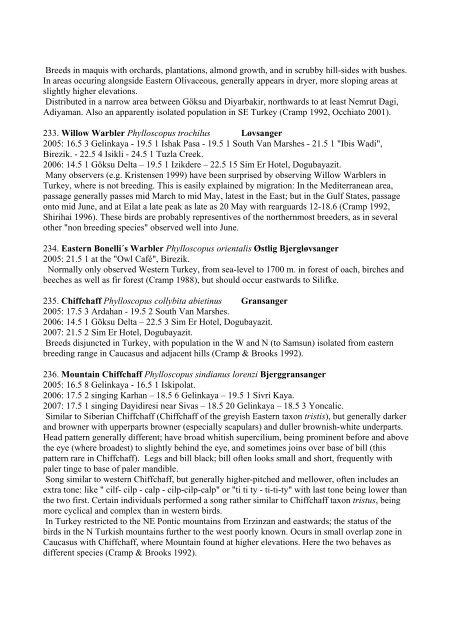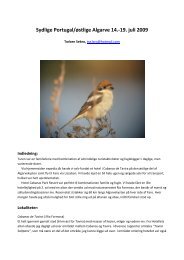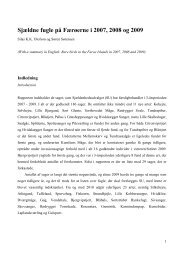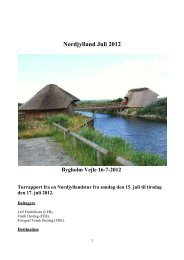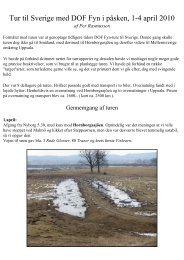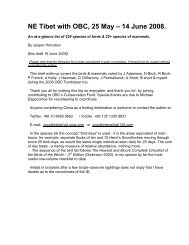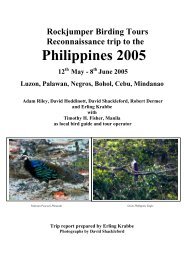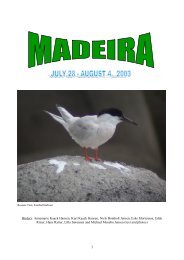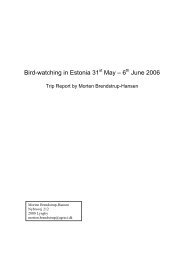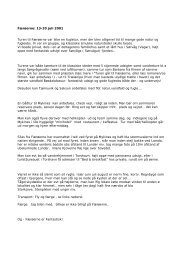TURKEY - a report from a birdwatching trip to Central ... - Netfugl.dk
TURKEY - a report from a birdwatching trip to Central ... - Netfugl.dk
TURKEY - a report from a birdwatching trip to Central ... - Netfugl.dk
Create successful ePaper yourself
Turn your PDF publications into a flip-book with our unique Google optimized e-Paper software.
Breeds in maquis with orchards, plantations, almond growth, and in scrubby hill-sides with bushes.<br />
In areas occuring alongside Eastern Olivaceous, generally appears in dryer, more sloping areas at<br />
slightly higher elevations.<br />
Distributed in a narrow area between Göksu and Diyarbakir, northwards <strong>to</strong> at least Nemrut Dagi,<br />
Adiyaman. Also an apparently isolated population in SE Turkey (Cramp 1992, Occhia<strong>to</strong> 2001).<br />
233. Willow Warbler Phylloscopus trochilus Løvsanger<br />
2005: 16.5 3 Gelinkaya - 19.5 1 Ishak Pasa - 19.5 1 South Van Marshes - 21.5 1 "Ibis Wadi",<br />
Birezik. - 22.5 4 Isikli - 24.5 1 Tuzla Creek.<br />
2006: 14.5 1 Göksu Delta – 19.5 1 Izikdere – 22.5 15 Sim Er Hotel, Dogubayazit.<br />
Many observers (e.g. Kristensen 1999) have been surprised by observing Willow Warblers in<br />
Turkey, where is not breeding. This is easily explained by migration: In the Mediterranean area,<br />
passage generally passes mid March <strong>to</strong> mid May, latest in the East; but in the Gulf States, passage<br />
on<strong>to</strong> mid June, and at Eilat a late peak as late as 20 May with rearguards 12-18.6 (Cramp 1992,<br />
Shirihai 1996). These birds are probably representives of the northernmost breeders, as in several<br />
other "non breeding species" observed well in<strong>to</strong> June.<br />
234. Eastern Bonelli´s Warbler Phylloscopus orientalis Østlig Bjergløvsanger<br />
2005: 21.5 1 at the "Owl Café", Birezik.<br />
Normally only observed Western Turkey, <strong>from</strong> sea-level <strong>to</strong> 1700 m. in forest of oach, birches and<br />
beeches as well as fir forest (Cramp 1988), but should occur eastwards <strong>to</strong> Silifke.<br />
235. Chiffchaff Phylloscopus collybita abietinus Gransanger<br />
2005: 17.5 3 Ardahan - 19.5 2 South Van Marshes.<br />
2006: 14.5 1 Göksu Delta – 22.5 3 Sim Er Hotel, Dogubayazit.<br />
2007: 21.5 2 Sim Er Hotel, Dogubayazit.<br />
Breeds disjuncted in Turkey, with population in the W and N (<strong>to</strong> Samsun) isolated <strong>from</strong> eastern<br />
breeding range in Caucasus and adjacent hills (Cramp & Brooks 1992).<br />
236. Mountain Chiffchaff Phylloscopus sindianus lorenzi Bjerggransanger<br />
2005: 16.5 8 Gelinkaya - 16.5 1 Iskipolat.<br />
2006: 17.5 2 singing Karhan – 18.5 6 Gelinkaya – 19.5 1 Sivri Kaya.<br />
2007: 17.5 1 singing Dayidiresi near Sivas – 18.5 20 Gelinkaya – 18.5 3 Yoncalic.<br />
Similar <strong>to</strong> Siberian Chiffchaff (Chiffchaff of the greyish Eastern taxon tristis), but generally darker<br />
and browner with upperparts browner (especially scapulars) and duller brownish-white underparts.<br />
Head pattern generally different; have broad whitish supercilium, being prominent before and above<br />
the eye (where broadest) <strong>to</strong> slightly behind the eye, and sometimes joins over base of bill (this<br />
pattern rare in Chiffchaff). Legs and bill black; bill often looks small and short, frequently with<br />
paler tinge <strong>to</strong> base of paler mandible.<br />
Song similar <strong>to</strong> western Chiffchaff, but generally higher-pitched and mellower, often includes an<br />
extra <strong>to</strong>ne: like " cilf- cilp - calp - cilp-cilp-calp" or "ti ti ty - ti-ti-ty" with last <strong>to</strong>ne being lower than<br />
the two first. Certain individuals performed a song rather similar <strong>to</strong> Chiffchaff taxon tristus, being<br />
more cyclical and complex than in western birds.<br />
In Turkey restricted <strong>to</strong> the NE Pontic mountains <strong>from</strong> Erzinzan and eastwards; the status of the<br />
birds in the N Turkish mountains further <strong>to</strong> the west poorly known. Ocurs in small overlap zone in<br />
Caucasus with Chiffchaff, where Mountain found at higher elevations. Here the two behaves as<br />
different species (Cramp & Brooks 1992).


